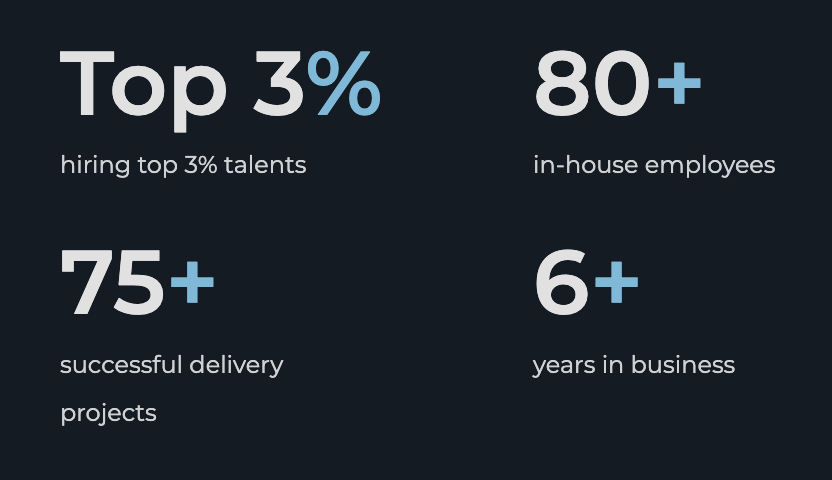Whether developing a mobile app, a custom e-commerce platform, or an enterprise software solution, finding the right software development partner is essential.
This is where a well-written Request for Proposal (RFP) comes into play. It is a vital tool that businesses use to outline their project requirements and solicit proposals from vendors, ensuring alignment and facilitating informed decision-making. So, how to write an RFP?
This comprehensive guide will walk you through the process of writing an effective RFP for software development. Based on the expertise of WeSoftYou, a leading custom engineering company, we will cover everything you need to know about RFP, which leads to successful partnerships and innovative software solutions. Let’s dive into the details.
What is an RFP for Software Development?

What is RFP in software development? A Request for Proposal (RFP) for software development outlines a project’s specific requirements and objectives. It is used to solicit proposals from software development vendors interested in bidding on the project. The RFP guides potential vendors to understand your project’s scope, objectives, and technical requirements before submitting their proposals.
Software development RFP is a crucial communication tool between an organization and potential software development vendors. It goes beyond just requesting pricing information. RFP provides a comprehensive overview of the project’s goals, requirements, and evaluation criteria. An effective RFP sets the stage for a collaborative and successful software development journey.
By clearly defining the project scope, deliverables, and technical specifications, a software request for proposal enables vendors to understand the organization’s unique needs and tailor their proposals accordingly. It ensures that the bids received align with the project’s objectives, allowing organizations to make informed decisions and hire the most suitable software development partner.
Who Should Write an RFP?

Writing an RFP typically falls on the shoulders of the organization seeking software development services. It can be a business, a government agency, a nonprofit organization, or any entity needing a software solution. Assigning this task to individuals or teams that deeply understand the project goals, technical requirements, and business objectives is crucial.
Determining who should write a software development request for proposal depends on the organization and project. Some key stakeholders can be involved in writing an RFP:
- Project Managers: They oversee the entire software development project and comprehensively understand the requirements, timeline, and objectives.
- Business Analysts: They gather and analyze business requirements, translating them into technical specifications. Their insights are valuable when defining the scope of the software project.
- IT Department Specialists: IT professionals with a solid technical background and expertise in software development can contribute to writing an RFP that aligns with the organization’s IT strategy and infrastructure.
It is essential to involve critical stakeholders who deeply understand the organization’s needs and can effectively communicate them in the RFP. Collaboration among these individuals or teams ensures that the RFP captures the organization’s goals and sets the stage for successful software development.
Benefits of Writing an RFP

Writing an RFP offers several benefits to organizations seeking software development services. Here are some key advantages:
- Clarity and Alignment: An RFP allows you to define your project requirements, objectives, and deliverables clearly. It ensures that all potential vendors comprehensively understand your needs, resulting in more accurate and aligned proposals.
- Efficiency and Time-Saving: By specifying your project details upfront, an RFP helps filter out vendors who do not meet your requirements, saving time for both parties. It streamlines the selection process and allows you to focus on evaluating proposals from qualified vendors.
- Competitive Proposals: A well-written RFP encourages vendors to submit competitive proposals, as they clearly understand your project goals and can provide tailored solutions. It promotes healthy competition among software development companies and increases the likelihood of receiving high-quality proposals.
- Vendor Evaluation: An RFP provides a structured framework for evaluating vendors based on their proposals. It allows you to assess each vendor’s expertise, approach, and capability to deliver the desired software solution.
What are the Differences between RFP, RFQ, and RFI?

You may encounter three similar-sounding acronyms: RFP, RFQ, and RFI. While they share some similarities, each serves a different purpose. Let’s briefly explore these distinctions.
Request for Information (RFI)
A Request for Information (RFI) is a preliminary step to gather information and better understand potential vendors and their capabilities. RFIs are typically used when the requirements are not well-defined or when you need more information to shape your project scope and objectives. The primary goal of an RFI is to gather information and identify potential vendors who meet your essential criteria.
Request for Quote (RFQ)
A Request for Quote (RFQ) is used when you have well-defined project requirements and seek vendor pricing information. An RFQ for software development focuses primarily on cost estimates and timelines. They are commonly used for projects with relatively straightforward requirements, emphasizing comparing vendor pricing and delivery schedules.
Request for Proposal (RFP)
A Request for Proposal (RFP) is the most comprehensive document. It outlines your project’s requirements, objectives, and evaluation criteria, seeking detailed vendor proposals. RFPs are used when you require more than just pricing information and want potential partners to understand how they will address your project’s needs comprehensively.
RFPs allow you to evaluate vendors based on their technical expertise, proposed approach, team composition, and previous experience.
Comparison table: RFP vs RFI vs RFQ
| Aspect | RFP | RFI | RFQ |
| Purpose | Detailed proposals from vendors | Gathering information | Pricing information from vendors |
| Project requirements | Well-defined | Not necessarily well-defined | Well-defined |
| Focus | Comprehensive understanding | Gathering basic information | Cost estimates and timelines |
| Evaluation criteria | Technical expertise, approach, etc. | N/A | Pricing, delivery schedules, etc. |
| Level of detail required | High | Low | Moderate |
Now that we have clarified the differences between RFP, RFI, and RFQ, let’s dive deeper into the critical components of an RFP for software development.
What Should be Included in an RFP?

To ensure that your request for proposal template for software development effectively communicates your project requirements and objectives, it should include the following key components:
1. The Executive Summary and Company Description
The executive summary provides an overview of your organization, the purpose of the software project, and its importance. It should concisely convey the context and goals of the project to potential vendors. The company description section offers background information about your organization, its mission, values, and any relevant achievements or industry recognition.
2. Project Goals
Clearly state the goals and objectives of the software project. Outline what you aim to achieve through the development of the software solution. Specify the desired outcomes, such as increased efficiency, improved user experience, or enhanced scalability.
3. Project Scope and Deliverables
Define the project’s scope by outlining the functionalities, features, and modules that need to be developed. Clearly articulate the deliverables and any specific milestones or timelines associated with the project. This section helps vendors understand the extent of the work involved and enables them to provide accurate proposals.
4. Budget
Provide a budget range or an estimated budget for the project. While it may not be possible to determine the exact cost at this stage, sharing a budget range helps vendors tailor their proposals accordingly. This information ensures that you receive proposals within your financial constraints.
5. Technical Requirements
Specify the software solution’s technical requirements. It includes hardware and software specifications, programming languages, databases, integrations, security considerations, scalability requirements, and other relevant technical details. Be as detailed as possible to ensure vendors understand the project’s technical complexity.
6. Response Timeline
Outline the timeline for the RFP process, including the deadlines for vendors to submit their proposals and the expected timeline for vendor selection. It helps companies plan their resources and provides clarity on the overall timeline of the software development project.
7. Possible Constraints
Identify any potential constraints that vendors should consider when developing their proposals. These constraints could include regulatory requirements, compliance standards, data privacy considerations, or other limitations that may impact the project’s implementation.
8. Contact Points
Provide contact information for individuals within your organization who can address queries and provide clarifications during the RFP process. Include names, email addresses, phone numbers, and preferred communication channels. Encourage vendors to seek clarification if they have any questions regarding the RFP.
By including these components in your software request for proposal template, you provide vendors with a clear understanding of your project’s requirements and enable them to submit proposals that align with your expectations. Additionally, you may use request for proposal software to help you draft this document.
RFP Examples for Software Development

To help you visualize the structure and content of an RFP for software development, here are a few examples of RFPs for different digital solutions:
Example 1: Custom CRM Software Development
Title: Request for Proposal for Custom Customer Relationship Management (CRM) Software Development
Executive Summary and Company Description
XYZ Corporation, a fast-growing manufacturing firm, invites reputable software development companies to submit their proposals for a custom CRM system. Our organization is expanding, and our current CRM system is insufficient to support our operations.
Project Goals
This project aims to improve customer relationship management, enhance sales tracking, and streamline customer service operations.
Project Scope and Deliverables
We require a custom-built CRM system with contact management, lead management, sales forecasting, and reporting capabilities. The CRM system should integrate seamlessly with our existing ERP system.
Budget
Our budget for this project is between $50,000 and $70,000.
Technical Requirements
The CRM system should be cloud-based, supporting multi-user access. It should have robust data analytics and reporting capabilities and allow integration with our existing ERP system.
Response Timeline
We require all proposals by July 1, 2023. We aim to finalize the contract by July 30, 2023, and the software should be ready for deployment by May 1, 2024.
Possible Constraints
The major constraint for this project is time. The CRM must be developed within the stipulated timeframe. Another constraint is the budget, which is fixed and cannot be exceeded.
Contact Points
For clarifications or queries regarding this RFP, please contact John Doe, Head of IT, at [email protected].
Example 2: Mobile Application Development
Title: Request for Proposal for Mobile Application Development for ABC Retail Store
Executive Summary and Company Description
ABC Retail Store, a leading retailer with a nationwide presence, invites submissions from experienced mobile application developers to create a retail mobile app. We aim to enhance our digital presence and provide customers with a seamless online shopping experience.
Project Goals
Our goal is to offer our customers a mobile application that allows them to browse our product catalog, make purchases, track their orders, and interact with our customer service.
Project Scope and Deliverables
We require the development of a mobile app compatible with both iOS and Android platforms. The app should be user-friendly, secure, and incorporate our brand identity.
Budget
Our estimated budget for this project ranges from $60,000 to $80,000.
Technical Requirements
The mobile app should have an intuitive user interface, seamless navigation, secure payment gateway integration, order tracking, and a robust customer support feature. The app should integrate with our existing inventory management system.
Response Timeline
All proposals must be submitted by July 20, 2023. We aim to finalize the vendor selection by August 15, 2023, and the mobile app should be ready for launch by January 15, 2024.
Possible Constraints
The project timeline and budget are our primary constraints. We expect the project to be delivered on time and within the stipulated budget. The app must also meet our high standards for quality and user experience.
Contact Points
For any inquiries or further clarification on this RFP, please contact Jane Smith, Digital Marketing Manager, at [email protected].
Example 3: Web-Based Project Management Tool Development
Title: Request for Proposal for Web-based Project Management Software Development
Executive Summary and Company Description
123 Consulting, a project management consulting firm, invites software development companies to submit their proposals for developing a web-based project management tool. We aim to streamline our project management processes and improve team collaboration.
Project Goals
The primary goal of this project is to increase efficiency, enhance collaboration among project teams, and improve tracking and reporting.
Project Scope and Deliverables
We require a web-based project management tool that supports task assignment, tracking, collaboration, and document sharing and visualizes project timelines.
Budget
Our budget for this project is between $80,000 and $100,000.
Technical Requirements
The tool should be web-based, user-friendly, secure, and scalable. It should allow for multiple users’ access and have strong data visualization capabilities for project tracking.
Response Timeline
All proposals should be submitted by August 15, 2023. We aim to finalize the vendor by September 15, 2023, and the tool should be ready for deployment by May 15, 2024.
Possible Constraints
The main constraints for this project are the fixed budget and the strict project timeline. Another potential constraint could be the integration with our existing systems.
Contact Points
For any questions regarding this RFP, please contact Mike Brown, Project Management Office Head, at [email protected].
You can use these examples as an RFP template for software development. Alternatively, you can find RFP template software to help you draft the document.
Tips to Write an Effective RFP

Writing an effective RFP can significantly impact the quality of proposals you receive and the success of your software development project. Here are some valuable tips when drafting your RFP:
- Be Clear and Specific: Clearly articulate your project requirements, goals, and technical specifications. Avoid ambiguity and provide as much detail as possible to ensure vendors fully understand your expectations.
- Focus on Outcomes, Not Solutions: Instead of prescribing specific technologies or solutions, emphasize the desired outcomes and functionalities. Allow vendors to propose innovative solutions based on their expertise and experience.
- Evaluate Vendor Qualifications: Include a section in your RFP that requires vendors to showcase their qualifications, relevant experience, and past projects. This helps you assess their expertise and align it with your project requirements.
- Ask for References: Request references from vendors to validate their track record and gain insights into their ability to deliver high-quality software solutions.
- Consider Scalability and Future Needs: If scalability is vital for your project, explicitly state it in the RFP. Ask vendors to explain how their proposed solution can accommodate future growth and evolving business needs.
- Encourage Innovation: Request vendors to provide details on how they plan to bring innovation and added value to your project. It encourages creative thinking and helps you identify vendors who can contribute unique perspectives.
- Include Evaluation Criteria: Define clear evaluation criteria in your RFP to assess and compare vendor proposals. It ensures a fair and consistent evaluation process. It helps you identify the most suitable partner.
- Proofread and Review: Before finalizing your RFP, proofread it thoroughly for any errors or inconsistencies. Seek input from key stakeholders to ensure the document accurately represents your organization’s requirements and expectations.
By following these tips, you can increase the effectiveness of your RFP and attract proposals from vendors who are well-aligned with your project goals.
Send Us Your RFP
At WeSoftYou, we understand the importance of a well-crafted RFP and its impact on the success of your software development project. Our experienced team of professionals is equipped to handle various software development needs across multiple industries.
If you’re looking for a dedicated and innovative software development company, we encourage you to send us your RFP. We have expertise in developing software solutions for e-commerce, social media, healthcare, e-learning, and more industries. WeSoftYou aims to bring about technological advancements and create groundbreaking products.
Streamline Your Software Development with WeSoftYou

Writing an RFP for software development is a critical step toward finding the right partner to bring your project to life. Following the guidelines outlined in this comprehensive guide, you can create an effective RFP that communicates your project requirements, attracts competitive proposals, and ensures a successful software development journey.
Remember, a well-written RFP sets the foundation for a strong partnership and paves the way for innovative and tailored software solutions. WeSoftYou is a company specializing in custom engineering and is known for setting a leadership standard in the industry. We prioritize understanding and meeting the specific needs of their customers and their projects and focus on making a product-based revolution in areas where science and technology intersect.
Contact us today to leverage our expertise and drive your software development project to success.
FAQ
When choosing an IT service provider, consider experience, expertise, client testimonials, cultural fit, technical capabilities, scalability, and security measures.
Include confidentiality and non-disclosure agreements, define intellectual property rights, address liability and indemnification, and consider provisions for dispute resolution in your RFP.
Conduct market research, send out RFIs for preliminary information, establish qualification criteria, distribute the RFP to shortlisted vendors, and evaluate proposals based on technical approach, experience, and budget.





















